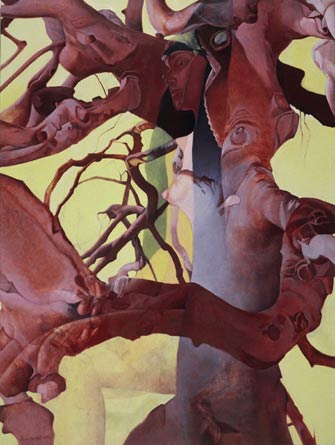by Theresa Noll

Carol Adams’s The Sexual Politics of Meat: A Feminist-Vegetarian Critical Theory is a pivotal feminist text in which Adams calls upon her readers to see the exploitation of women and the exploitation of animals as part of the same system of oppression. This is an analysis that is still as crucial today as it was two decades ago, when the book was originally published.
Adams explains that the cultural obsession with women’s “parts” (breasts, thighs, butts), evident in advertising and pornography and played out in everyday rituals and conversation, is inextricably linked to our culture’s tendency to value animals as nothing but sources of beef, bacon or veal. In both cases, beings are reduced to objects available for consumption. They are subject to fragmentation and dismemberment, their individuality rejected and their individual and collective power quelled. Adams contends that a system that values any beings, human or nonhuman, only for the money they can reap for those in power will never be the right foundation for women’s equality. Instead of distancing themselves from animals in an effort to reject the points of crossover linking them as victims of oppression, women, and especially feminists, have a responsibility to place animal rights at the center of their activism.
In the 20 years since the original publication of Adams’s award-winning work, women have made gains in equality, and vegetarianism and cruelty-free farm practices have moved toward the mainstream. And yet, we continue to find that even well-meaning activists have yet to make the connection between the two movements. In a recent ad campaign, Pamela Anderson, clad in a bikini, perches on a bed in a classic pin-up pose. Her body is segmented and labeled by part — ribs, round, rump — butcher-shop style. It’s similar to the vintage illustration featured on the cover of The Sexual Politics of Meat, intended to blatantly connect the dots between the exploitation of women and that of animals. In fact, Anderson agreed to the pose in the name of animal rights; the ad — which reads, “All animals have the same parts” — is for PETA (an organization which, significantly, has a long history of conflict with feminists for using women’s bodies in their advertising). But it’s clear that the reason she was placed in that position had nothing to do with connecting feminist dots. When the ad was banned in Montreal for being too risqué, she told reporters that she felt it was “sad that a woman would be banned for using her own body in a political protest over the suffering of cows and chickens.” In imploring people not to eat meat, Anderson offered herself in exchange. One object for another, a breast for a breast: an equal trade.
It is of course common to see women’s bodies being juxtaposed with animals’ and “used” for reasons that make no attempt to be high-minded. KFC recently kicked off an ad campaign of their own for the Double Down sandwich, paying college women $500 apiece to hand out free samples on campus while wearing sweatpants with “Double Down” printed across the seat. Adams provides plenty of examples of this sort of objectification, from Burger King ads to album covers to restaurant menus.
The Absent Referent
Each of these images deals in a concept Adams refers to as the absent referent. Since the college women handing out sandwiches are valued for only their butts, their personhood is absent from the scene. The sandwiches they hand out have an absent referent, too: the living animal who existed before being relabeled meat. It’s no accident that all these reduced parts are interchangeable, with both the sandwich and the women’s butts sporting the name “Double Down.” As Adams writes, “we distance whatever is different by equating it with something we have already objectified.”
The fact that one absent referent is the same as another bolsters Adams’s insistence that the feminist agenda must consider animal rights of fundamental importance; to ignore animals’ right to exist as individuals is to engage in the same system that oppresses women. Thus, Lady Gaga, who has called herself a feminist, revealed a hole in her personal ideology when she wore a dress made of meat to accept her Video Music Award, and then again on the The Ellen DeGeneres Show. She said her intention was to point out that she’s “not a piece of meat,” and that if we don’t fight for our rights, pretty soon we’re going to have “as much rights as the meat on our bones.” But her “statement” was just the other side of the coin represented by PETA’s Pamela Anderson ad. Lady Gaga offered up butchered meat in place of a segmented woman’s body, but the concept is the same: something, someone, was sacrificed and silenced to grab attention, to make a point, to gain a sort of power. Lady Gaga’s naive exchange of meat for attention was not much better than KFC’s trading in women’s butts for easy cash.

Another prominent figure who has lately called herself a feminist, Sarah Palin, employed the absent referent concept metaphorically when she began calling herself and her conservative women followers Mama Grizzlies. Palin, outspoken killer of wolves and lover of meat (“If God had not intended for us to eat animals, how come He made them out of meat?” she said in an interview last year has coopted the mythical personality traits of the grizzly bear for her own use with no regard for the individual animals whose name she has taken. In doing so she is removing from our view the plight of actual grizzlies, largely absent in North America due to the over development of their habitat. She is happy to use grizzly bears’ name while advocating drilling in Alaska — an activity that destroys grizzly homes along with the rest of the environment.
The Earth As Another Source of Profit
Taking Adams’s analysis beyond women and animals, it is plain to see that we are surrounded by absent referents. Real trees become mere symbols when we use their leaves and branches as logos even as forests are being clearcut to make way for more subdivisions. As the rainforests turn to deserts and the glaciers melt into mud, subway ads show images of tanned, happy women in tropical paradises, beckoning us to visit islands that have been tailored to accommodate human desires. The absent referent here is a healthy earth, a whole ecosystem. Fly over the United States in a plane and the earth, too, is sectioned into parts. The ability for places themselves to have wildness and individuality has been eradicated, all due to a dominant culture that sees women, animals and our very landbase as potential sources of profit.
As Adams writes, “justice should not be so fragile a commodity that it cannot be extended beyond the species barrier of Homo sapiens.” As long as women see animals and the natural world as objects placed on earth for thoughtless, insatiable consumption, we are feeding a dominant culture that processes our own bodies through the same system. As women enjoy the gains we have made in the path to our own equality, we must continue to assert our own presence and recognize our uniquely personal stake in fighting for those who are still being silenced.
Theresa Noll is a freelance book editor and writer in Brooklyn. She is currently editing Merle Hoffman’s forthcoming memoir, “Intimate Wars.”
Also see Lady Gaga: Celebrity Feminist? by Nona Willis Aronowitz in this edition of On The Issues Magazine.
Also see Women’s Liberation: Looking Back, Looking Forward by Carol Hanisch in this edition of On The Issues Magazine.
Also see Do Feminists Need to Liberate Animals, Too? by Merle Hoffman in the Spring 1995 edition of On The Issues Magazine.
Visit The Café of On The Issues Magazine for new stories and updates.
